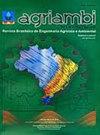Production of Bambusa vulgaris seedlings from rhizomes under brackish water irrigation
IF 1.4
4区 农林科学
Q3 AGRICULTURAL ENGINEERING
Revista Brasileira de Engenharia Agricola e Ambiental
Pub Date : 2020-05-01
DOI:10.1590/1807-1929/agriambi.v24n5p337-342
引用次数: 1
Abstract
ABSTRACT The objective of this study was to evaluate the influence of irrigation with brackish water on the production of bamboo seedlings (Bambusa vulgaris). The experiment was carried out at the Fazenda Experimental Piroás, in the municipality of Redenção, CE, Brazil (4° 14’ 53” S, 38° 45’ 10” W, and altitude of 230 m), in a completely randomized design with five treatments and six repetitions. The treatments consisted of five irrigation water electrical conductivity (ECw): 0.5 (control); 1.5; 2.5; 3.5 and 4.5 dS m-1. At 120 days after the beginning of the application of the treatments the leaf gas exchange, relative chlorophyll index (RCI), plant height (H), shoot dry matter (SDM), H/SDM ratio, and the concentrations of Na+ and K+ in stems and leaves were evaluated. Salt tolerance indexes were calculated based on SDM, H, photosynthesis rate and RCI. The increase in the ECw reduced leaf gas exchange, and the reduction in the photosynthesis rate was caused by stomatal and non-stomatal effects. The salinity affected negatively the growth and quality of bamboo seedlings, with the greatest effects being with ECw equal to or greater than 2.5 dS m-1. Bamboo seedlings present Na+ retention in the stems and low Na+/K+ ratio in the leaves. Bamboo seedlings are tolerant to salinity up to 1.5 dS m-1, indicating that waters with this salinity can be used for seedling production of this species, without loss of growth and quality.微咸水灌溉下竹根茎育苗的研究
摘要本研究旨在评价微咸水灌溉对竹苗生产的影响。实验在巴西redeno市(4°14′53”S, 38°45′10”W,海拔230 m)的Fazenda实验Piroás进行,采用完全随机设计,共5个处理,6个重复。灌溉水电导率(ECw): 0.5(对照);1.5;2.5;3.5和4.5 dS m-1。在施用后120 d,测定了各处理叶片气体交换、相对叶绿素指数(RCI)、株高(H)、地上部干物质(SDM)、H/SDM比值以及茎叶中Na+和K+浓度。根据SDM、H、光合速率和RCI计算耐盐指标。ECw的增加降低了叶片气体交换,光合速率的降低是由气孔和非气孔效应引起的。盐度对竹苗的生长和品质有负向影响,以ECw≥2.5 dS - m-1时影响最大。竹苗茎部Na+滞留,叶片Na+/K+比例较低。竹子幼苗对高达1.5 dS - m-1的盐度具有耐受性,这表明具有这种盐度的水可以用于该物种的幼苗生产,而不会影响其生长和质量。
本文章由计算机程序翻译,如有差异,请以英文原文为准。
求助全文
约1分钟内获得全文
求助全文
来源期刊

Revista Brasileira de Engenharia Agricola e Ambiental
Agricultural and Biological Sciences-Agronomy and Crop Science
CiteScore
2.70
自引率
16.70%
发文量
114
审稿时长
3-8 weeks
期刊介绍:
A Revista Brasileira de Engenharia Agrícola e Ambiental (Agriambi), periódico oficial da Asociación Latinoamericana y del Caribe de Ingeniería Agrícola (ALIA), é editada mensalmente, no formato eletrônico, pela Unidade Acadêmica de Engenharia Agrícola (UAEA) do Centro de Tecnologia e Recursos Naturais (CTRN) da Universidade Federal de Campina Grande (UFCG), destinando-se à divulgação de artigos científicos originais e inéditos, elaborados em Português, Inglês ou Espanhol. Com o auxílio de pareceres de Consultores, os artigos são aceitos ou não pela Equipe Editorial para publicação na Revista. A Agriambi aceita, também, a submissão de contribuições na modalidade de revisão de literatura.
 求助内容:
求助内容: 应助结果提醒方式:
应助结果提醒方式:


